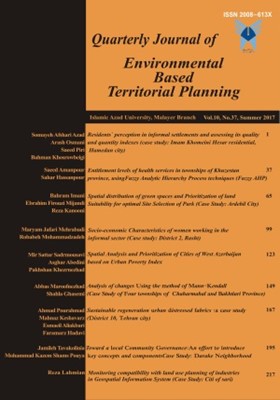Socio-economic Characteristics of women working in the informal sector (Case study: District 2, Rasht)
Subject Areas :Robabeh mohammadzadeh 1 , Maryam Jafari Mehrabadi 2
1 - M.A. Student of Geography and urban planning, Faculty of Literature and Humanities, University of Guilan
2 - Assistant Prof, Geography and urban planning Department, Faculty of Literature and Humanities, University of Guilan
Keywords: Women, Socio-economic Characteristics, Rasht, Informal employment,
Abstract :
Along with increasing population of cities, informal employment is considered to be an integral part of the economy of the cities, which is known as a source of subsistence for poor families of the each city. A considerable part of informal labor force consists of street vendors throughout the world, working in public spaces of the cities. Most of them are women. In this study, women street vendors have been investigated as one of the aspects of informal businesses. It also aims to scrutinize the social-economical characteristics of women working in the informal sector in district two of Rasht, streets and places where they sell their products, and also their geographical origins. The method is survey with descriptive-analytical approach. Data collection tool is questionnaires and interviews. Data analysis findings are as follows: Most of studied woman are either illiterate or unlearned. Most of them live in rural areas of Rasht. Most of them are between 40 and 59. Most of them are the only financial supplier for their households. More than half of studied population sells vegetables and other sorts of perishable substances. Respectively the streets of Sardar-E-Jangal, Motahari, and Shariati are hosting the most women working as street vendors. Most of them are from villages.
1) اسفندیاری، ع، پدرام، م، مجدم، ص.1392. اقتصاد غیررسمی، خانه داری زنان و عوامل موثر بر آن (مطالعۀ موردی زنان متأهل شهر اهواز). مطالعات اجتماعی روان شناختی زنان، 11 (4): 91-114.
2) پورتال منطقه دو شهرداری رشت. 1394. دستیابی در 22-2-1394. mant2.rasht.ir.
3) جمالی، ف، صدر موسوی، م، لیوارجانی، پ. 1388. بررسی ویژگی های اجتماعی- اقتصادی شاغلان بخش غیررسمی در مادرشهر تبریز (نمونۀ موردی سبزه میدان). نشریه جغرافیا و برنامه ریزی (دانشگاه تبریز) ، 14 (29): 87-115.
4) رنانی، م، اربابیان، ش، میرزایی، م. 1390. شناخت ساختار اشتغال زنان در بخش غیررسمی کشور. فصلنامه تحقیقات اقتصادی راه اندیشه. (1): 38-62.
5) رنانی، م، میرزایی، م، اربابیان، ش. 1391. بخش غیررسمی و ظرفیت مالیاتی از دست رفته (مطالعه موردی: استان کهگیلویه و بویراحمد). فصلنامه پژوهشنامه اقتصادی (رویکرد اسلامی- ایرانی)، 12 (44): 99-130.
6) سازمان برنامه و بودجه. 1385. نتایج تفصیلی سرشماری عمومی نفوس و مسکن شهرستان رشت.
7) سلیمی فر، م ، کیوانفر، م. 1389. اقتصاد غیررسمی در ایران و اثر تورم بر آن. مجله دانش و توسعه، 17 (33): 1-27.
8) شرکت مهندسی طرح کاوش. 1386. طرح جامع شهر رشت. جلد هفتم (فصل دوم- بخش دوم). رشت: وزارت مسکن و شهرسازی (سازمان مسکن و شهرسازی استان گیلان).
9) صفایی گنجین، م. 1384. کـار شایسته و اقتصاد غیر رسمی. مجله کار و جامعه. (62): 44-47.
10) ضابط محبوب، ح، امینزاده، ب، برنافر، م. 1394. توزیع تراکم جمعیت در شهر رشت با استفاده از روش AHP. فصلنامه آمایش محیط. 8(28): 1-22.
11) کاظمی پور، ش. 1385. تحولات اخیر و آیندۀ وضعیت اشتغال و بیکاری در ایران با تأکید بر وضعیت اشتغال زنان. نامۀ انجمن جمعیت شناسی ایران. (1): 20-42.
12) مشکینی، ا، موذن، س، 1394. تحلیل حکمروایی مطلوب شهری در پایداری شهرها مطالعه موردی: شهر عجب شیر. فصلنامه آمایش محیط. 8(29): 99-132.
13) نامدار، م. 1389. عوامل موثر بر اشتغال زنان همراه با ورود فناوری های نوین به عرصه اقتصاد روستایی: مطالعه موردی کمباین داران استان فارس. فصلنامه روستا و توسعه. (2): 103-128.
14) نساجی، ز. 1384. زنان، اشتغال، خانواده. فصلنامۀ درسهایی از مکتب اسلام. (6): 56-67.
15) نوری، ه، جمینی، د، جمشیدی، ع. 1392. تحلیل فضایی شاخص های عمدۀ اشتغال زنان در کشور. مطالعات اجتماعی روان شناختی زنان. 11 (3): 81-102.
16) Alter Chen, M. 2013. Women in thr informal sector: A Global picture, the Global movement. WIEGO.1-10.
17) Bromley, R. 1978. Introduction -The Urban Informal Sector:Why Is It Worth Discussing ?. Pergamon Press. 6 (9/10): 1033-1039.
18) Gërxhani, K. 1999. The Informal Sector in Developed and Less Developed Countries A Literature Survey. Amsterdam Institute for Advanced Labor Studies (AIAS). 1-43.
19) Hussmanns, R. 2004. Measuring the informal economy: From employment in the informal sector to informal employment. Working Paper. (53): 1-32.
20) ILO. 1972. Employment, Income and Equality: A Strategy for ILO.
21) Mahadevia, D, Vyas, S, Mishra, A. 2014. Street Vendors in Ahmedabad, India. IEMS (Informal Economy Monitoring Study). March. Accessed 1393-11-12. www.wiego.org.
22) Nastiti, A, Prabaharyaka,I, Roosmini, D, Dermawan Kunaefi,T, 2012. Health-associated Cost of Urban Informal Industrial Sector:An Assessment Tool. Social and Behavioral Sciences. (36): 112-122.
23) Roever, S. 2011. Women in Informal Employment: Globalizing and Organizing. How to Plan a Street Trader Census. February. Accessed 1393-11-23. www.wiego.org.
24) —. 2012. IEMS (Informal Economy Monitoring Study.The Urban Informal Workforce: Street Vendors. Accessed 1393-12. http://wiego.org/.
25) —. 2014. IEMS (Informal Economy Monitoring Study). Sector Report: Street Vendors. April. Accessed, 1394-01-08.
www.wiego.org.
26) Tomal, A, Johanson, L, 2008. Earnings determinants for self-employed women and men in the informal economy: the case of Bogota, Colombia. Pi Gamma Mu. 83 (1/2): 71-84.
27) V. Ramani, Sh, Thutupalli,A , Medovarszki, T, Chattopadhyay,S, Ravichandran, V, 2013. Women in the Informal Economy: Experiments in Governance from Emerging Countries. Policy Brief (United Nations University).
28) Vanek, J, Alter Chen,M, Carré, F, Heintz, J, Hussmanns, R, 2014. Statistics on the Informal Economy: Definitions, Regional Estimates & Challenges. April. Accessed, 1393-12-22. http://wiego.org.


